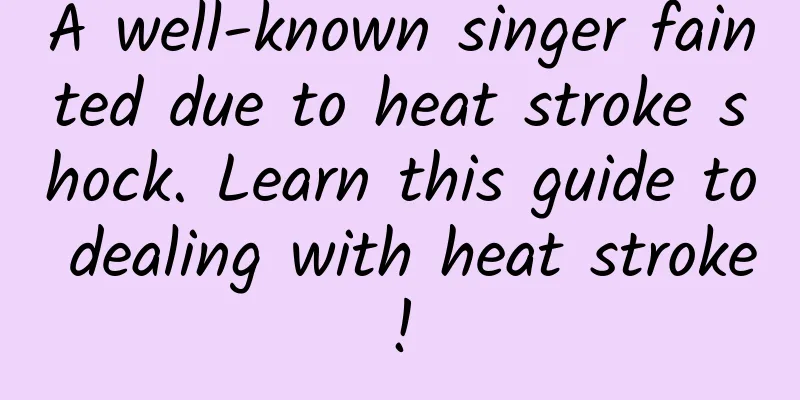A well-known singer fainted due to heat stroke shock. Learn this guide to dealing with heat stroke!

|
It was reported that singer Eason Chan fainted due to heat stroke shock while playing tennis outdoors on June 10. When he fell, his chin hit the ground and fractured his cheekbone. Related report screenshots On June 9, a day before, a woman died of heat stroke while hiking outdoors. Since the Dragon Boat Festival holiday, the Central Meteorological Observatory has issued high temperature warnings one after another. Shandong, Henan, Hebei, Anhui, Xinjiang and other places have all experienced high temperature weather recently. Related report screenshots On a global scale, on June 5, the European Union's climate monitoring agency released a report claiming that the world had just experienced the hottest May on record. This is the 12th consecutive month that the global monthly average temperature has broken the highest record for the same period . In India, where the temperature exceeded 50 degrees Celsius in many places last month, more than 200 people died of heat stroke . In the face of the scorching summer and the increasingly hot climate of the earth, "heat to death" is really not a joke. Dealing with high temperatures and heat stroke is becoming more and more a necessary skill for us. Today, let us re-understand "heat stroke"! What is heat stroke? Heatstroke refers to a heat injury disease with central nervous system and cardiovascular dysfunction as the main manifestations, caused by excessive loss of water and electrolytes and impaired heat dissipation in the high temperature, high humidity and stuffy environment, which leads to excessive core temperature of the body. Copyright images in the gallery. Reprinting and using them may lead to copyright disputes. Heat stroke is a life-threatening emergency that can lead to permanent brain damage or kidney failure, or even death, due to central nervous system and circulatory dysfunction. Why does heatstroke occur? The main causes of heat stroke are increased heat production and heat dissipation disorders. In hot weather, either of these two conditions may lead to heat stroke. 1 Increased heat production In a high temperature (temperature above 32°C), high humidity (humidity greater than 60%), and poorly ventilated environment, long-term heavy physical labor will increase the body's heat production. For example, farmers working in the fields, workshop workers, etc. Some diseases such as hyperthyroidism, high fever, chills, status epilepticus, etc., will also cause the body to produce more heat. 2 Heat dissipation barrier When the ambient temperature rises, some susceptible people, such as the elderly, the weak, and those with poor organ reserve function, have impaired body temperature regulation and do not cool down or drink water in time. People with large-area burns, sweat disorders, scleroderma, obesity, and overly thick clothing are also prone to heat dissipation difficulties. Typical symptoms of heat stroke 1 Premonitory heat stroke After working or living in a high temperature environment for a period of time, if you experience thirst, fatigue, sweating, dizziness, tinnitus, headache, nausea, chest tightness, palpitations, and inattention, and your body temperature is still below 38°C, it is the precursor stage of heat stroke. At this time, you should leave the high temperature environment in time, increase heat dissipation, lower your body temperature, and stop the progression of the disease. 2 Mild heat stroke If the pre-heatstroke is not treated in time, it will progress to the mild heatstroke stage. In this stage, the body temperature will rise to more than 38 degrees Celsius, the skin will feel hot, and early circulatory dysfunction will appear, such as pale face, cold limbs, decreased blood pressure, and increased heart rate. 3 Severe heat stroke Symptoms include high fever, convulsions, seizures, shock, coma, etc. Severe heatstroke can be divided into three types according to different manifestations. Heat cramps It is more common in young and middle-aged people, and often occurs during strong physical work or exercise in a hot environment . The patient is conscious and has a normal body temperature. If not treated in time, it may progress to heat stroke. After sweating, a large amount of water and salt are lost. Insufficient salt supplementation causes hyponatremia, which manifests as intermittent spasms of the trunk and limbs, especially gastrocnemius spasms. Intestinal spasm may also occur, which usually lasts for 3 minutes and can be relieved. Heat exhaustion It often occurs in the elderly, children and patients with chronic diseases , and can develop into heat stroke. Symptoms include high fever and insufficient blood volume due to excessive water loss. Manifestations include dizziness, vertigo, headache, nausea, vomiting, pale complexion, cold and clammy skin, profuse sweating, increased breathing, weak pulse, arrhythmia, syncope, muscle spasms, decreased blood pressure and even shock. Heat stroke Heat stroke is the most serious type of heat stroke. Working or exercising for several hours in a high temperature, high humidity or strong sunlight environment (exertional); or elderly, weak or chronically ill patients staying in a high temperature and poorly ventilated environment for several days (non-exertional) will cause the body's heat stress mechanism to decompensate, causing a sudden rise in core body temperature, leading to central nervous system and circulatory dysfunction, and heat stroke. Heat stroke may also cause high fever, no sweating, and unresponsiveness to calls. The body temperature may be as high as 40-42℃ or even higher. There may be coma, convulsions, rapid breathing, tachycardia, pupil constriction, positive meningeal irritation signs, etc. In severe cases, there may be shock, heart failure, cerebral edema, respiratory failure, acute renal failure, acute liver failure and other multiple organ failure. First aid for heat stroke After working for a long time in a hot environment, if you experience sweating, thirst, dizziness, headache, high fever, etc., it is very likely that you have heat stroke. The prognosis of heat stroke is related to the degree of high fever, duration, cooling speed, and degree of damage to important organs. If treatment is delayed, the mortality rate can reach 80%; if it can be diagnosed early and cooling treatment is timely, the mortality rate can be reduced to 10%. Although some cases of heat stroke are very serious and severe cases may lead to death, not all cases of heat stroke require medical treatment. Generally , patients with pre-heat stroke and mild heat stroke can recover to normal after timely on-site rescue. However, patients with severe heat stroke should be transferred to the hospital immediately . The basic principle of treatment is to lower the core body temperature and prevent organ failure. 1 Premonitory and mild heat stroke Once found, immediately move to a cool, ventilated environment, remove clothing, take oral saline or salt-containing electrolyte drinks, and wipe the whole body with a wet towel to cool down before recovery. For those who cannot drink water and are not conscious, send them to the hospital for intravenous rehydration. 2 Heat cramps After initial treatment according to the above precursors and treatment methods for mild heatstroke, seek medical attention promptly, replenish with sufficient sugar and salt water, slowly stretch, massage and knead the spasmodic muscles to relax the muscles, and antispasmodic and analgesic drugs can be used. 3 Heat exhaustion Make the person suffering from heat stroke lie flat, raise the lower limbs , and send to the doctor promptly after initial treatment according to the above signs and treatment methods for mild heat stroke. Cool down quickly and promptly, replenish sugar and saline, restore blood volume, prevent hypotension, and ensure blood supply to important organs. 4 Heat stroke After first aid treatment on site, send the patient to a doctor promptly for oxygen inhalation and cooling. The cooling speed is closely related to the prognosis. The higher the body temperature and the longer it lasts, the more severe the tissue damage and the worse the prognosis. The temperature should be reduced to below 39°C within 1 hour. Ice caps, ice blankets, and ice packs placed on the large arteries (carotid artery, axillary artery, femoral artery, popliteal artery, etc.) can be used to help cool down. At the same time, 200 ml of ice saline can be used for gastric or rectal lavage; 1000-2000 ml of ice 5% glucose saline can also be used for intravenous drip, or low-temperature dialysate (10°C) can be used for hemodialysis. Electrolytes can be supplemented to correct electrolyte disorders and acidosis; brain edema and convulsions can be prevented; the respiratory tract can be kept open; organ dysfunction and gastrointestinal bleeding can be prevented. Prevention of heat stroke 1. Pay attention to weather forecasts, understand extreme high temperature warnings, and arrange travel activities appropriately. 2. When engaging in outdoor activities, avoid periods of high temperatures, wear light and breathable clothing, wear a sun hat, sunglasses, and apply sunscreen. 3. Eat a light diet, drink water in time, and drink electrolyte sports drinks after sweating profusely. 4. Learn the symptoms and signs of heat stroke-related diseases, identify heat stroke in a timely manner, and master general treatment methods. 5. Special attention should be paid to groups at high risk of heat stroke, such as infants, people over 65 years old, the frail and sick, the obese, and those who do long-term, high-intensity physical labor. 6. If you experience symptoms such as dizziness, palpitations, etc. in a high temperature environment, you need to stop working immediately and rest in a cool place. May everyone have a safe and cool summer. Planning and production Produced by: Chinese Medical Association Author: Liu Xiaomeng, Emergency Department, China Rehabilitation Research Center Reviewer: Liu Huizhen, deputy chief physician of the emergency department of China Rehabilitation Research Center, doctor of medicine Editor: Cui Yinghao and He Tong Proofread by Xu Lailinlin |
Recommend
Experience in operating knowledge accounts with millions of followers on Douyin
2021 is already half over. Where are the opportun...
Kuaishou live broadcast promotion and traffic generation skills!
How effective is Kuaishou live streaming? Everyon...
How is the development of ultra-high-definition broadcasting abroad?
The noisy 2014 has finally passed. In this year, ...
If you don’t make good use of these 8 tools, you can’t be considered a good student!
01 Reading is the fastest, most effective and mos...
The first red alert! Nanning suffered heavy rain and many places in the city were flooded. How to prevent it scientifically?
Summer rain comes as soon as it is expected. On t...
It’s the season of blue tears again! But…isn’t this really ocean pollution?
It’s the season for blue tears to sweep your scre...
Looking back at 10 years of LCD TVs: How did they kill plasma?
For those born in the 1980s and even the 1990s, t...
"Life Search Engine" lands on iPhone, Black Mirror becomes reality
The smart mobile assistant connected to the big m...
You must try this crispy and tender ivory vegetable once!
In addition to enjoying the flowers blooming all ...
Learn these 4 tricks and do marketing as well as Durex!
By cleverly leveraging the momentum, a tornado-li...
The Ministry of Industry and Information Technology has asked app stores to remove apps exposed during the 315 Party
[[387969]] Last night, CCTV's 315 Gala expose...
Lemon Class-Advanced Performance Testing of Software Testing
Course Catalog ├──001 Opening Ceremony.ts 170.53M...
New way to monetize incentive videos: How to conquer tool apps?
Native video is attracting more and more attentio...
How to improve the ranking of Baidu AiPurchasing? How to optimize products in Baidu Aicaigou store?
Baidu Ai Purchasing is a B2B vertical industry eco...
iOS9 Learning Series: MapKit Transit
Each iteration of MapKit brings some new features...









